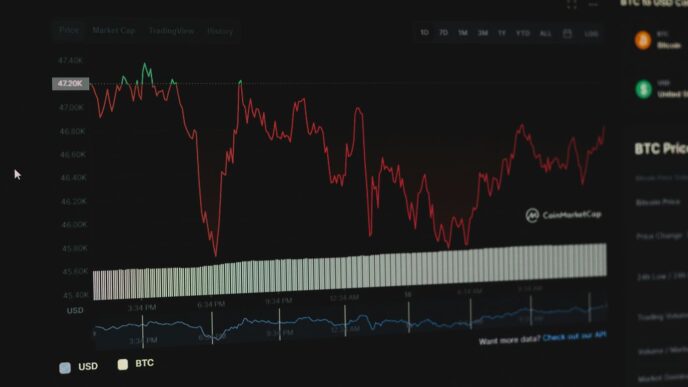Ever wonder what makes some brands stand out while others just blend in? A big part of it is something called thought leadership content. It’s not just about putting out any old article; it’s about sharing smart ideas that show you really know your stuff. This guide will walk you through what thought leadership content is, why it matters, and how you can start creating it to help your business shine.
Key Takeaways
- Thought leadership content helps build your brand’s good name and makes you seem trustworthy.
- It’s different from regular content marketing because it focuses on showing deep knowledge, not just selling things.
- Creating this kind of content can help people make better choices and helps your business get noticed.
- You need real experts and a steady stream of good ideas to make thought leadership content work.
- There are many ways to share thought leadership, like detailed reports, online talks, or articles in other publications.
Defining What is Thought Leadership Content

Understanding Thought Leadership Content Marketing
Okay, so what is thought leadership content marketing? It’s more than just throwing some blog posts online. It’s about a brand giving away free stuff – but that "stuff" is trustworthy info from people who actually know their stuff. These experts share what they know through articles, videos, and even social media, all to teach potential customers or make their industry better. Brands use this to get people to trust them and look good in their field. It’s about sharing original ideas, unique perspectives, or firsthand experience, distinguishing it from broader content marketing practices.
The Core of a Thought Leadership Strategy
A thought leadership strategy? That’s when you focus less on making sales right now and more on showing that you’re an expert. The main goal is to answer the big questions that people in your field are asking. It’s about leading the conversation, not just joining in. Think of it this way: content marketing earns trust over time, but thought leadership earns respect. It’s about positioning your brand as a leading voice in your industry.
What Defines a True Thought Leader?
So, what makes someone a thought leader? Well, they’re industry experts who really get what’s going on. They can teach people about upcoming trends and important topics. To create thought leadership content, you need a few things:
- Experts: You need people who know their stuff to write the content. They don’t have to be employees; you can even license content from other places.
- Consistency: One piece of content won’t do much. You need to keep creating content to keep people interested.
- Measurement: You need to track how well your content is doing and use that information to make your content strategy better.
Thought Leadership Versus Content Marketing
Distinguishing Thought Leadership from General Content Marketing
Content marketing and thought leadership? People often mix them up, but they’re not the same thing. Think of content marketing as the foundation. It’s about creating and sharing stuff – blog posts, videos, social media updates – to get people interested in your brand. Thought leadership, on the other hand, is about positioning yourself as an expert, someone who’s shaping the industry. It’s less about selling and more about sharing insights and new ideas. A good content strategy is important for both, but the goals are different. One aims to attract, the other aims to influence.
The Role of Content Marketing in Building Thought Leadership
So, how does content marketing help with thought leadership? Well, it’s the vehicle. You need content to share your ideas and build your reputation. Regular blog posts can show you know your stuff. Case studies can prove your methods work. Social media can help you engage in conversations. It’s all about consistently putting out high-quality material. Think of it like this: content marketing builds the platform, and thought leadership is what you put on it. It’s about creating quality content marketing assets that showcase your knowledge.
Why Thought Leadership Elevates Expertise
Thought leadership takes your brand beyond just being another company. It shows you’re a leader, someone others look to for guidance. It’s not just about answering questions; it’s about asking the right ones. When you share unique insights and challenge the status quo, people start to see you as an authority. This builds trust and respect, which can lead to more opportunities and a stronger brand. It’s about articles that offer a fresh perspective and establish you as a go-to source in your field.
Benefits of Thought Leadership Content for Businesses
Building Credibility and Enhancing Reputation
Thought leadership content is more than just blog posts; it’s about showing you know your stuff. When you consistently share smart, well-researched insights, people start to see you as a go-to source. This builds trust, which is super important in today’s world where everyone is trying to sell something. Think of it as earning respect, not just attention. It’s about thought leadership content that really connects with people.
Driving Informed Decision-Making for Audiences
One of the best things about thought leadership is that it helps people make better choices. It’s not about pushing a product; it’s about giving your audience the information they need to solve problems. This can take many forms:
- Explaining complex topics in a simple way.
- Offering different perspectives on industry trends.
- Providing data-backed insights that people can use.
When you do this, you’re not just selling; you’re helping. And that builds loyalty. It’s like giving someone a map instead of just telling them to buy your compass. This approach to content marketing can really set you apart.
Standing Out in a Crowded Market
Let’s face it: there’s a lot of noise out there. Everyone is shouting for attention, and it’s hard to get noticed. Thought leadership helps you cut through the clutter by offering something different: real value. Instead of just saying you’re the best, you show it through your content. This can involve:
- Sharing unique research findings.
- Challenging conventional wisdom.
- Offering innovative solutions to common problems.
By doing this, you position yourself as a leader, not just another follower. It’s about B2B content marketing strategy that makes a real impact.
Essential Elements for Creating Thought Leadership Content
The Importance of Expert Voices
To really make an impact, thought leadership content needs to come from people who know their stuff. It’s not enough to just rehash old ideas; you need insights that are fresh and based on real, hard-won experience. Think about it – would you rather listen to someone who’s just read about a topic, or someone who’s lived it? It’s the same with your audience. They want to hear from experts who can offer unique perspectives and leadership skills that they can’t find anywhere else. If you don’t have those experts in-house, consider partnering with industry leaders or licensing content from reputable sources.
The Need for Consistent Content Production
One-off blog posts or articles aren’t going to cut it. Building true thought leadership takes time and effort. You need to consistently put out content that keeps your audience engaged and coming back for more. Think of it like building a relationship – you can’t just show up once and expect people to trust you. You need to be there, providing value, over and over again. Here’s a few things to keep in mind:
- Set a realistic schedule: Don’t overcommit and burn out. Start with a manageable frequency and adjust as needed.
- Plan ahead: Create a content calendar to keep track of topics and deadlines.
- Repurpose content: Turn a white paper into a series of blog posts, or a webinar into a podcast. Get the most out of what you create.
Measuring the Impact of Thought Leadership
How do you know if your thought leadership efforts are actually working? You need to track the right metrics. It’s not just about vanity metrics like page views or social media likes. You need to look at things like:
- Engagement: Are people spending time reading your content? Are they sharing it with their networks? Are they leaving comments and asking questions?
- Lead generation: Is your thought leadership content driving leads? Are people downloading your ebooks or signing up for your webinars?
- Sales: Is your thought leadership content ultimately leading to sales? This can be harder to track, but it’s the ultimate measure of success. You can audit content to see what’s working and what’s not.
Here’s a simple table to illustrate some key metrics:
| Metric | How to Measure | What it Tells You |
|---|---|---|
| Time on Page | Google Analytics | How engaging your content is |
| Social Shares | Social media analytics | How shareable your content is |
| Lead Conversions | Marketing automation platform | How effective your content is at generating leads |
| Sales Influence | CRM data, customer surveys | How much your content contributes to sales |
Sources of High-Quality Thought Leadership Content

Leveraging Counter-Narrative Opinions
Want to really grab attention? Try going against the grain. Strong opinions that challenge common beliefs in your industry can be gold for thought leadership content. It’s not just about being a rebel without a cause, though. Your counter-narrative needs to be credible and well-supported. Think about it: everyone’s saying one thing, and you come along with a fresh, insightful perspective. That’s how you spark conversation and position yourself as a true thought leader. It’s about adding something new to the discussion, not just arguing for the sake of it. You need to back up your claims with solid evidence and reasoning. This approach can really help you improve content marketing ROI.
Harnessing Personal Narratives and Case Studies
Stories sell. People connect with personal experiences, so sharing your own journey or highlighting the successes of your clients can be incredibly powerful. A well-told story can illustrate complex concepts in a relatable way. Think about turning your experiences into case studies. What challenges did you face? How did you overcome them? What lessons did you learn? These narratives not only showcase your educational but also build trust with your audience. People want to know that you’ve been in their shoes and that you understand their pain points. Don’t be afraid to get personal and share your vulnerabilities. It’s what makes your content authentic and engaging. Here’s a simple structure for a compelling case study:
- The Challenge: Clearly define the problem your client faced.
- The Solution: Explain the strategies you implemented to address the challenge.
- The Results: Quantify the impact of your solutions with data and metrics.
Utilizing Industry Analysis and Data Storytelling
Data is your friend. In today’s world, everyone is looking for solid evidence to back up claims. Dive into industry trends, conduct your own research, and present your findings in a clear and compelling way. Original research and data analysis can really set you apart. Don’t just throw numbers at your audience, though. Tell a story with the data. What are the key takeaways? What do the trends suggest for the future? How can your audience use this information to make better decisions? Consider these sources for industry insights:
- Government reports and publications
- Industry-specific research firms
- Academic journals and studies
By combining data with storytelling, you can create thought leadership content that is both informative and engaging. This approach helps you build credibility and establish yourself as a trusted source of information in your industry.
Types of Thought Leadership Content Formats
Thought leadership isn’t just about what you say, but also how you say it. The format you choose can significantly impact how your message is received. It’s about finding the right vehicle to carry your insights to your audience. Let’s explore some popular formats:
In-Depth White Papers and Ebooks
When you need to really explain important concepts, white papers and ebooks are your friends. These longer-form pieces allow for detailed analysis, research, and the presentation of complex ideas. They’re great for lead generation, too, as you can offer them in exchange for contact information. Think of them as the deep dives of the content world.
Engaging Webinars and Podcasts
Webinars and podcasts bring a human element to thought leadership. They allow for interaction, Q&A sessions, and a more conversational tone. These formats are excellent for building relationships with your audience and showcasing personality. Plus, they’re easily accessible and can be consumed on the go. It’s like having a virtual coffee with an industry expert.
Bylined Articles and Sponsored Posts
Getting your name and ideas published on reputable industry websites can do wonders for your credibility. Bylined articles and sponsored posts offer a platform to reach a wider audience and establish yourself as a true thought leader. Just make sure the content is genuinely insightful and not overly promotional. It’s about sharing your knowledge, not just selling your product.
Building a Robust Thought Leadership Strategy
It’s easy to think that just churning out content is enough, but a real thought leadership strategy needs more. It’s about becoming the go-to source when people are trying to understand what’s happening in the industry. It doesn’t just happen; you need a plan.
Aligning Thought Leadership with Business Goals
Too often, thought leadership feels like a separate project. It should be directly tied to what you’re trying to achieve as a business. What does success look like? Are you trying to reach new markets? Then your content should address their concerns. Targeting bigger clients? Speak to their level. Make sure everything you do connects back to measurable goals.
Coordinating Messaging Across All Channels
Your LinkedIn posts, webinars, blog posts, and even your sales materials should all sound like they’re coming from the same place. Consistency builds trust, and trust is super important in thought leadership. Think of it as brand consistency across the board. If your messaging is all over the place, people won’t know what to believe.
Empowering Sales and Customer Service Teams
Thought leadership isn’t just marketing fluff. It’s real information that your sales and customer service teams can use every day. Give them the latest insights, articles, and industry takes so they can have smarter conversations with prospects and clients. It’s about giving them the tools to be more effective. Think of it as providing them with sales enablement resources.
Here’s a simple way to think about it:
- Provide: Give your teams the content.
- Train: Show them how to use it.
- Support: Be there to answer questions and provide context.
Conclusion
So, we’ve talked a lot about what thought leadership content is all about. It’s not just putting out a bunch of articles; it’s about being a real voice in your field. When you share smart ideas and new ways of looking at things, you build trust with people. This kind of content helps you stand out and shows everyone you know your stuff. It takes some effort, sure, but the payoff is big. You get to shape conversations and become someone people listen to. That’s pretty cool, right?
Frequently Asked Questions
What exactly is thought leadership content?
Thought leadership content is like sharing really smart ideas and information from people who are experts in their field. It’s not just about selling stuff; it’s about teaching and helping others understand important topics. Think of it as giving away valuable knowledge for free to build trust and show you know your stuff.
What makes someone a real thought leader?
A true thought leader is someone who deeply understands their industry. They’re not just repeating what everyone else says; they’re bringing new ideas, looking ahead at trends, and helping others make sense of complex things. They’re like a guide who can show you the way in a tough area.
How is thought leadership different from regular content marketing?
While both use content to reach people, thought leadership goes a step further. Regular content marketing aims to get people interested and build a relationship. Thought leadership, however, focuses on showing off deep knowledge and making your brand or yourself known as a top expert. It’s about earning respect, not just attention.
What do I need to create thought leadership content?
Creating this kind of content needs a few key things: first, you need real experts to share their insights. Second, you have to be consistent – one good piece isn’t enough; you need to keep putting out valuable information regularly. And third, you need to check if it’s actually working so you can make it even better.
Where can I find good ideas for thought leadership content?
You can find great ideas for thought leadership by looking at opinions that go against the grain, sharing personal stories about what you’ve learned, digging into industry trends and data, and even using information your own company has gathered. Sometimes, you can also get content from other trusted sources.
What kinds of content can be considered thought leadership?
Thought leadership content can come in many forms, like detailed reports (white papers), longer digital books (ebooks), live online talks (webinars), audio shows (podcasts), and articles written by experts for other websites or magazines. The best format depends on what you want to teach and who you’re trying to reach.














